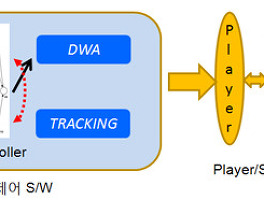Laser-based leg detection with experimental attributes and using Human Walking Model for Human following
As robot technology advances, robot requires more abilities to interact with humans as, not merely as industrial machines. Robots used for service such as a guide, escort and nursing need to have human-friendly navigation. Human-friendly navigation is an important technique for service robots to conduct service tasks.
So far, in research of autonomous mobile robot navigation, humans are regarded as dynamic obstacles. However, many technologies have studied about human detection using sensors like a LRF(Laser Range Finder), voice recognition, RFID, and vision sensor. To apply these skills to mobile robot, there are several requirements.
Our approach is to detect legs using only one LRF. Since the LRF is always installed in a robot for autonomous navigation such as localization and avoidance obstacles, there is no additional cost. Our proposal method detects human legs with a variety of attributes that are obtained from experiments on leg data through one LRF and for a mobile robot to track human in real time with low computation cost. The boundaries of attributes are defined by SVDD to make them reliable and have high probability. Also, we extract the attributes of walking legs in order to apply them to distinguish target person in a cluttered situation and suggest a walking model for the case of leg-detection failure and the loss of tracking because of individuals who cross-walk between the mobile robot and the target person. In experiments, we will confirm its possibility in a virtual environment.
Sick LMS200 localization obstacle avoidance
The SVDD is one of the best-known outlier detection and novelty detection method, in which one tries the strategy of suing balls defined on the feature space in order to distinguish a set of normal data from all other possible abnormal objects.
In virtual environment, there could be situation such as occlusion by other people. At the moment of occlusion, the target person’s legs are able to be hidden. To overcome this problem, we want to predict the target person’s leg position and follow the target person by matching through prediction.
tcycle is the sum of tswing and tstance. Normally, tstance is the lapse of time from when the heel touches the ground till the toe leaves the ground. However, we cannot figure out these instants of time through a LRF. We regard tstance as the duration for which the foot is completely on the ground. The mean of the leg displacement is 5.2cm and the maximum is 9.8cm. tswing can be defined as remained time without tstance in tcycle
'Research' 카테고리의 다른 글
| Laser Range Finder의 반사강도를 이용한 차선 정보 추출 (0) | 2010.01.27 |
|---|---|
| Coordination of multiple control schemes (0) | 2010.01.27 |
| 차량견인 트레일러 시스템의 운전자 친화형 후진제어 기법 개발 (0) | 2010.01.25 |
| Experimental construction and comparison of motion model of wheeled mobile robot (0) | 2010.01.21 |
| 거리센서에 기반한 안전하고 빠른 주행기법 개발 (0) | 2010.01.21 |














